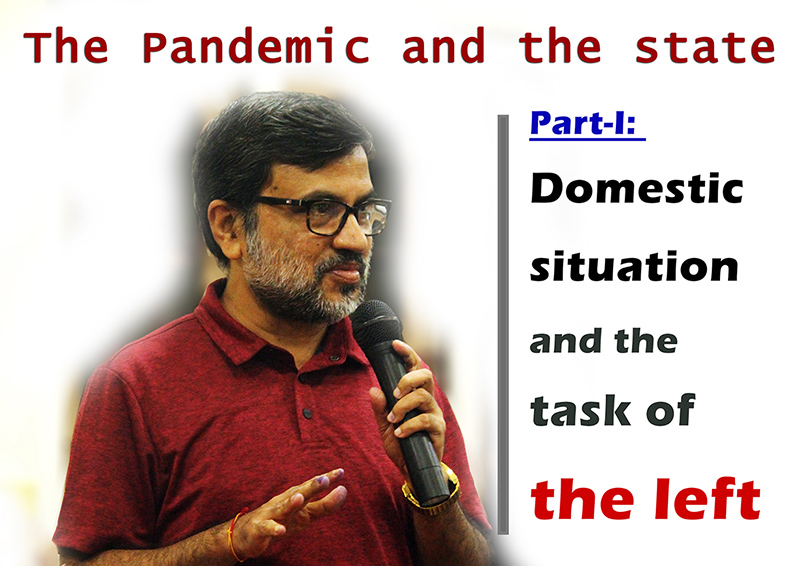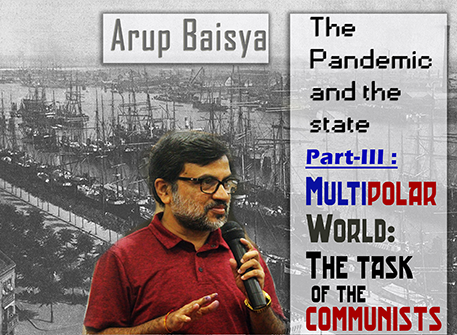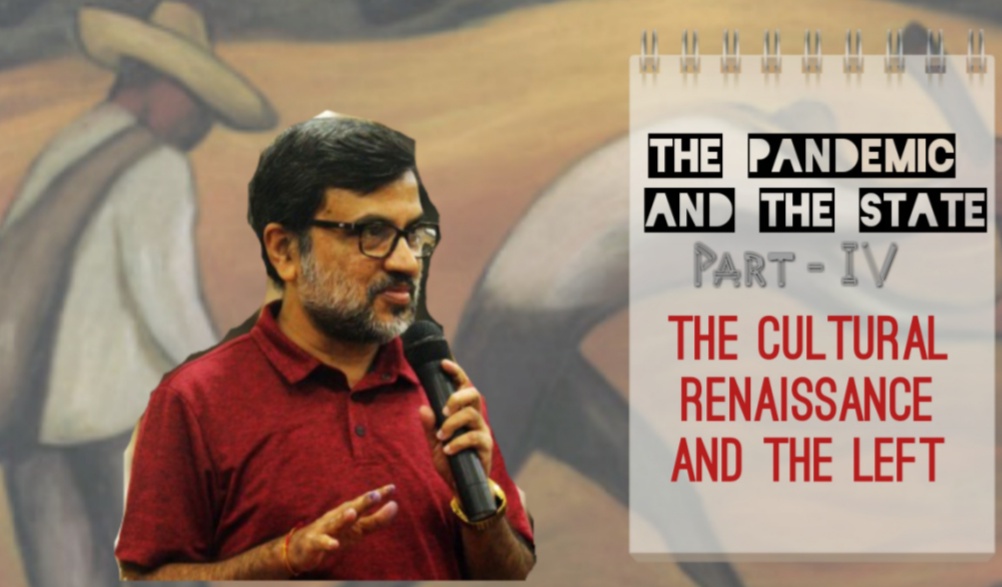The Pandemic and the state Part : I
Posted by
( baisya_arup@rediffmail.com )

https://www.frontierweekly.com/views/may-20/13-5-20-The%20Pandemic%20and%20the%20state-1.html?fbclid=IwAR30gcti_fdH6q3g3HIL8SdF7yKpTqYCjtGTVHR2AHF2kvORL1lz-9Tfx1E
The Pandemic and the state : Part-I : Domestic situation and the task of the left
The Pandemic and the state
Part-I: Domestic situation and the task of the left
Arup Baisya
Introduction
The best part of Marxist discourse is that it teaches us to dig deep below the surface to uncover the underlying relationship and process and that’s why Marxism itself is a process. In this context, it is not incongruous when G. A. Cohen asks “If Physics, the science of matter, cannot be designated by any ism against any particular name of the scientist because it’s a progressive discipline, is it pertinent question to ask why the social science be designated by any such ism? Is it not a progressive science?” Marxism unveils the surface relation of commodity exchange, where the labour-power becomes a commodity for exchange in a Capitalist society, is the manifestation of the social relation of production which is dynamic and always in motion. But even after a prolonged period of demise of really existing socialism in erstwhile Soviet Russia and entire Eastern Europe, the dominant discourse of Marxist praxis is revolving around the surface categories and confines the working-class movement within the domain of the game of bargaining within the capitalist system.
The Plan Vs. the Market
This dominant and parliamentary left in India focuses on Plan Vs. Market contradiction and the state-planned economy prevailing over the Market rule as the point of departure as well as a qualitative change. This obscures the fact that capital and its process of accumulation and profit plays as the constant category in the contradictory denomination of plan and market and the real question of the class character of the state goes beyond the political imagination of the working class. They shift their coordinates of observation and rests on Galilean transformation and conveniently forget that the capital with its profit and accumulation is the constant from whatever coordinate one observes and that’s why the observer must opt for Lorenz transformation for relativity, the relativity of class position i.e. the dynamics of the social relation of production and the intervention of the class whose interest is served by the power of the state. Charles Bettelheim cogently said, “The effective process of work, production, distribution, consumption which take place in the workplace, in the production units, in the consumption units, and which the plan is supposed to determine, can only have a very distant relation to what the plan anticipates, a circumstance which can transform the latter into a “myriad reality”. Such a process of mythification can itself be analysed only in terms of class and ideological relations.” The long drawn out history of capitalism has revealed the fact that the ‘Leissez faire’ economy is a misnomer and capitalism cannot survive without the support of the state. The distinction between the neoliberal phase of the economy and its earlier phase is the mere domination of the market over the state. The plan and the market can pari passu exist and also one may prevail over the other. But the moot question is the dynamics of the social relation of production and the regulation of its movement by the political class power. So, the vision of the left to go beyond capitalism primarily depends on the empowerment of the toiling masses as a whole and proletariat in particular.
So programme for radical change must begin with a question of ‘who is in control’ of the production process. Revolution does not only mean the dislodging or overthrowing ruling class from the control of the state but also the change of relation between state, capital, and labour in a radical way. It means the revolution is also a social revolution. From the global perspective, it also means bridging the metabolic rift between labour and nature to ensure the existence of an individual in nature through creatively controlled productive activity and that can be only be ensured by replacing the productive activity destructively dominated by capitalist-expansion or globalization of capital. The process of proletarianisation in a developing country cannot be articulated in isolation. The conditions of labour in developing countries are incomparably worse than the developed countries. But the countries concerned are an integral part of the system of capital and labour. The conditions of the labour market were deteriorating everywhere, including the western capitalist countries before the unprecedented Covid19 Pandemic.
Capitalist Crisis and the lockdown
The Kondratieff crisis of capitalism started in the late 1960s or early 1970s that led to the neoliberal policy paradigm which has traversed its full cycle to reach the cul-de-sac. Though the meteoric rise of speculative financial market and the process of labour arbitrage and the accumulation through displacement, the rate of falling profit due to change of organic composition of capital for capitalist competition leading to monopoly capitalism could somehow be managed from time to time, the crisis of overproduction due to the unabated accumulation of capital prevail across the capitalist global system. The Capitalist policymakers strived to keep the capitalist machine running through a bubble economy. The debt bubble followed by the US Subprime crisis in 2008-09 which was mitigated by quantitative easing (QE) and based on the logic of “too big to fail” was on the verge of bursting before the eruption of Covid19 Pandemic and the lockdown thereon.
The concept of ‘Market Justice’ and ‘Money illusion’ that has been created during neoliberal restructuring has now come to a halt by the Corona lockdown, the root cause of this catastrophe being capitalism itself due to the complete metabolic rift between labour and nature. But this inevitable consequence of the journey of capitalism also gives rise to the opportunity of building new relation between human beings and nature in contradistinction to the primitive communism where men were part of nature as well as a part of the animal kingdom too as unintelligent unconscious being. Due to the Corona lockdown, the global supply chain and massive revenue-generating private productive and service sectors have almost been completely disrupted, and wealth destroyed. Due to a fall in consumption, oil shock and Russia – US tug-of-war on curtailment on production is looming large, but the revenue saved by oil-importing countries like India can be expended on health-sector. The offensive stance of the US against China necessitates closure ties between Russia and China for their mutual benefit.
Due to the breaking down of the global supply chain, production, and circulation of most of the essential FMCG products for exchange value are now operative on a very limited scale within the domestic market. Another such booming market is in the health sector and that too mostly confined in domestic requirement. Health and food are the two things that are required most now. The farmers’ produced needs to be reached to the people and exchanged. But an exchange cannot be possible as people who lost their jobs do not have money and due to disruption in the market-driven supply chain. One option for the Government in power is the intervention of state through large scale purchase of agricultural goods with support price and ensure delivery to the consumers, universal ration system, community kitchen, and putting money in the hands of the people. A similar massive intervention of the state in the health sector is the only option.
Two options for the ruling class
The illusory and anti-people ‘Market Justice’ took its toll on the people and then its Capitalist production process itself entered the blind alley of crisis due to overproduction and now collapsed by this Corona catastrophe. This should revive the concept of ‘Social Justice’ where the state acts for the welfare of the people. Indian Govt is making its move through baby steps without giving any sign of a paradigmatic shift. It allocated a very meager amount of money for people’s welfare, transferring some amount of funds to the states respecting the federal spirit. But to take a giant stride, the Govt needs to change its policy decisions which the govt is hesitating to take to keep the corporate private players, who are visualising this catastrophe as an opportunity due to wealth destruction, in good humour.
CII is still advising austerity and asking govt to keep the money for the bailout of banks in case of failure or run. Vedanta chairperson posing himself as a great philanthropist, upholding the plight of daily wage earners, and making a huge charitable donation is advocating a theory of “the state has no business in business” and advising the govt to withdraw from its business which is still under govt control. Private hospital owners started nudging the govt for fiscal support for their revenue loss. This indicates a new kind of nationalism is on the platter now whereby the rate of exploitation will increase with a new restructuring of the working class. In this policy framework, both the ruling class parties, BJP and Congress, may converge on policy issues.
But the most reactionary forces of the power-that-be are still eyeing on the neoliberal policy framework. The defining feature of the neoliberal era is the large-scale shift of this production process to low-wage countries. The rate of exploitation and accumulation of profit is increased through a low investment of fixed and variable capitals i.e. transfer of capital. Rising surplus-value through expanding the exploitation of Southern low-wage labour is the wage-arbitrage driven globalization of capitalist production process which directly corresponds to the reduction of wages below their value. The neo-liberal regime of monopoly capital has thus taken the full control in the production process of developing countries and to ensure the super-exploitation of labour and nature of third world countries and the abundant supply of cheap labour and wealth, the accumulation through dispossession or continuation of primitive accumulation is increasingly important for capitalism’s survival in its present phase of capitalist crisis. This accumulation through dispossession is creating a reserve army of labour which creating downward pressure on the wages. By uprooting of hundreds of millions of workers and farmers in Southern nations from their ties to the land and their jobs in protected national industries, neoliberal capitalism has accelerated the expansion of a vast pool of super-exploitable labour.
Global labour arbitrage or super-exploitation is forcing down the value of labour-power. The proletarians of the developing countries are its first victims, but broad masses of working people in the imperialist countries also face destitution.
The rate of exploitation (the ratio between necessary labour time and surplus labour time) is increased by increasing the absolute surplus value (lengthening working day) and by increasing relative surplus value (increasing the productivity of labour through technology). But the global labour arbitrage, the driver of the global shift of production to the low-wage nation, is the form of surplus-value for super-exploitation which is ensured in the global south for rising unemployment due to the inability of modern production method to soak up enough labour, a much harsher labour regime, political repression, etc.
The Pandemic lockdown has displaced the migrant workers back to their rural base. The huge retrenchment of workers is going on and thus raising the rate of unemployment. The huge social cost that needs to be expended for engaging the living labour with the productive machine for kickstarting the production process necessitates the intervention of the state with a policy of generating domestic market instead of export-driven growth only model. Though the export market has drastically shrunk due to the lockdown, demand crunch, and the global tendency of the countries for a shift towards inward-looking domestic economic policies, the corporates are averse to such paradigmatic shift from export-led growth only model to the domestic national economy. The most reactionary forces within powers-that-be consider it as an opportune moment to attract the FDI of the corporates to shift their investment from China to India when China is imposing state control over the market rule. These foreign private players may shift their production unit to India only when the cheap labour, ownership rights with 100% stake or by other means, land grabbing through forced displacement and other facilities are extended to them provided other factors like global scenario for export demand, etc. are favourably changed post-lockdown economic reconstruction. This entails curtailment of workers’ rights, enhancement of pre-capitalist repression based on caste and community, etc. But the ruling class is also aware of the fact that such a policy framework not only fail to resolve the crisis but also aggravate the crisis and class conflict and militant protest.
Ideological front
Indeed, the “theories” peddled by the Hindutva outfits for the treatment coronavirus like cow-dung and cow urine are met by people with contempt at this time and the crisis itself is a good teacher for building scientific temper. It is also naïve to ask the question to Mr. PM’s “Dia Jalao” program, “Where is the science in it?”. It is like asking “Where is the science in Space, Time or Spacetime?”. The argument that science is defeated in Mr. PM’s program is an unreasonable argument and self-defeating.
But an attempt has been made to transform it into an imaginary construction of “Patriotism” which reifies or fetishises the real social solidarity and thus obscures the real social consciousness which leads us to be patriotic to the people belonging to a territory defined as India.
What Mr. PM did was an attempt to take it to an imaginary plank to epitomise the meaning of patriotism within himself to arrogate the power of people as an icon who can rule and thus serve the interest of India Inc and corporates and becomes their darling.
The patriotism with a herd popular mindset behind an icon is a transient phenomenon and may be effective for a very short term. But the herd mentality, if not reversed very quickly, has its adverse ramification. The loss of rationality and good sense may even confuse the long drawn out battle against the invisible enemy through a misleading signal. The counter-narrative of patriotism needs to be built from below by the power of the toiling masses and educated rational minds. Everything does not go as smoothly as the ruling class envisages, this is now unfolding itself.
https://nayaganatantra.wordpress.com/2020/05/11/pandamic-and-the-state-ab/?fbclid=IwAR3UC0acO_y-yAhi9KH3y3zuDRGrVko5A2htOkL1vB69U70LVpamPUDq8oM




.jpeg)







